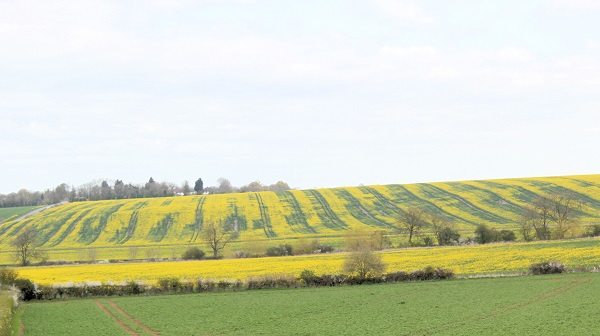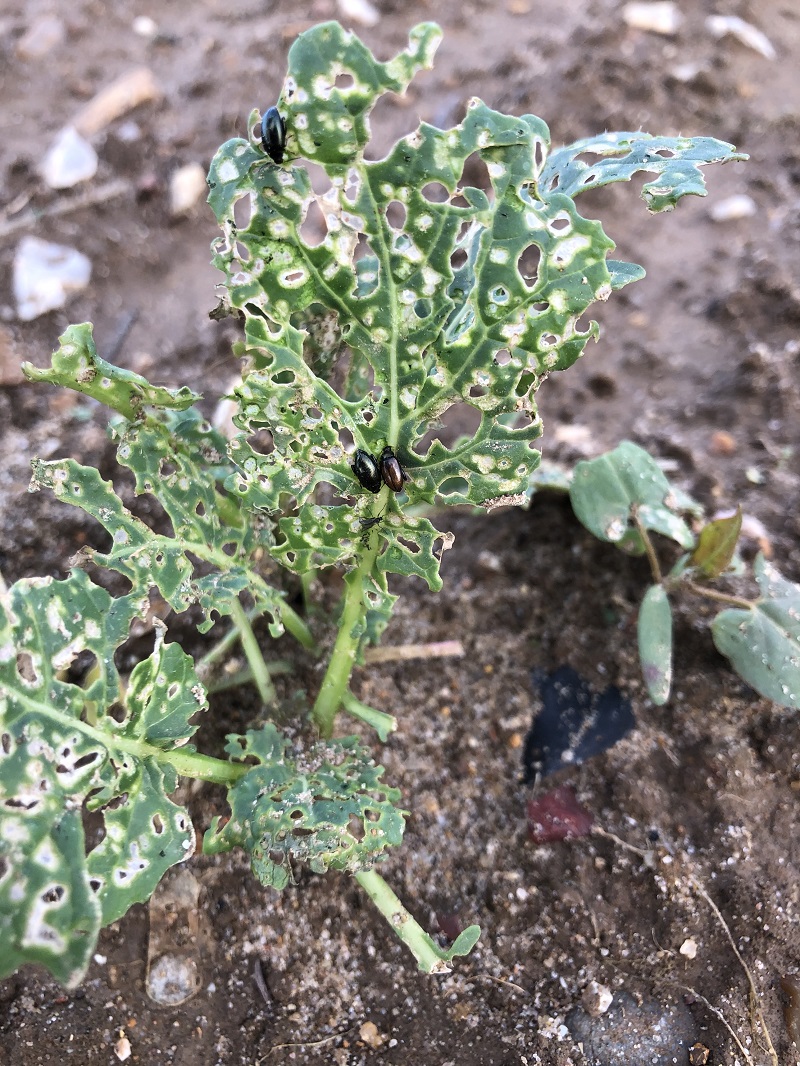Researchers at John Innes Centre have been studying genetic solutions to cabbage stem flea beetle. In the first of a new series, CPM explores some of the research that will help growers fight the threat.
Knowing your enemy has to be the key to tackling flea beetle.
By Rob Jones
An enterprise threat with serious rotational consequences. A problem made worse by key agrochemical withdrawals and increasingly resistant populations. And one that’s spreading across the country with few signs of rapid resolution.
Cabbage stem flea beetle has certainly become the bane of many oilseed rape growers’ lives in recent years. But it wasn’t so very long ago that many wheat growers were facing a remarkably similar challenge with blackgrass.
While still a major issue, the positive progress made in understanding how to control this weed means it no longer threatens the future of wheat-growing in some parts of the country quite as much as it once did. It’s said the days of simple ‘out-of-the-can’ solutions are long gone and continued pressure is essential to keep on top of the problem. However, focused research and practical experience have shown that blackgrass can be contained and managed.

Several years of Agrii research has highlighted clear associations between pest damage and varietal growth characteristics.
“Just like blackgrass, dealing with CSFB will almost certainly involve a combination of different varietal, rotational, agronomic and other strategies based firmly on understanding the pest,” says Bayer’s Dekalb technical specialist, Richard Phillips. “Encouragingly, there are already plenty of indications of how best we can do this from science and practice up and down the country.
“A number of approaches to managing the flea beetle risk so far identified by leading researchers and specialists are showing considerable promise in ensuring OSR can maintain its value in as many rotations as possible.
“These include varietal tolerance; crop avoidance and escape mechanisms; techniques for confusing or diverting the pest; biological control opportunities; and a range of other management options.”
At the John Innes Centre just outside Norwich, Professor Steven Penfield, Dr Rachel Wells and their team are already well on the way to understanding CSFB and identifying genetic solutions based on varietal tolerance.
Since establishing the first captive population of the pest in 2014 they have gained valuable insights into what makes CSFB tick, elements of its life cycle that might usefully be interrupted and possible natural population control mechanisms.
What’s more, their work – funded by AHDB, BBSRC and industry – has identified significant variations in the tolerance of different OSR accessions and other closely related brassicas to both adult beetles and their larvae.
“Knowing your enemy has to be the key to tackling flea beetle,” insists Rachel. “Yet, when we started looking into the problem in 2013 it rapidly became apparent there was nowhere near enough science in anyone’s understanding of the pest. Most of what was ‘known’ about it in the literature was anecdotal.
“We also realised that massive variations across individual crops and the many factors influencing the scale and location of the adult and larval damage as well as significant interference from other pests like cabbage root fly and stem weevil meant field trials were most unlikely to give us the reliable understanding we needed.
“So, we established a captive population in a controlled environment as the basis for our work. In addition to enabling us to measure the effects of specific levels of pest challenge on different OSR lines, maintaining this has taught us a lot about what CSFB needs to survive and thrive.
“For instance, we know emerging young adults don’t survive well in hot, dry conditions. They need moisture and shelter while they mature. Equally, we are learning what conditions trigger egg-laying, maximise egg-hatch and contribute to the greatest larval success and most rapid generation turnover.”
The JIC team has also been able to characterise a parasitic wasp and, in collaboration with the University of Warwick, identify entomopathogenic fungi having significant effects on beetle populations.
Undoubtedly their most valuable work, though, has been in identifying marked differences between OSR lines in both their attractiveness to adult flea beetle grazing and their ability to support larval development.
“We’ve assessed the diversity set of almost 100 Brassica napus lines forming the key Defra-sponsored OSR Genetic Improvement Network (OREGIN) resource for their palatability in carefully controlled adult feeding trials,” explains Steven Penfield.
“Assessment of scanned leaf images shows the average degree of damage varies significantly from 2-20% across these lines.
“Regardless of adult grazing levels, we are also finding marked differences between the success of larval development across the same OSR lines,” he continues. “We measure this by placing a set number of eggs in the soil at the base of each plant isolated in its own chamber and maintained under precisely the same environmental conditions.
“Following the whole life cycle through, we’ve recorded a four-fold difference in the number of adults actually emerging among the lines tested. This indicates valuable variations in their ability to tolerate the larvae as well as their attractiveness to adults.
“Because the OREGIN lines have all been subject to high density DNA mapping, ordering a total of 225,000 markers, we are able to correlate the traits we see in both respects with specific areas of the OSR genome to provide a valuable resource for plant breeding.”
While varieties bred for tolerance to flea beetle using this resource will be a number of years away, the JIC work offers more immediate value as a screening tool for existing genetic material. The team’s parallel assessment of two RL varieties, for instance, reveals significant differences between them in larval success.
“With sufficient support we could screen all current and emerging varieties as well as breeder’s lines and hybrid parents for tolerance to both adult feeding and larval success,” says Rachel. “This would give growers a valuable head start as far as genetic solutions are concerned.
“Of course, genetics will only be part of the solution, as we learnt to our cost in field trials this season testing the adult feeding tolerance we’ve identified in our growth chamber work. The more tolerant lines certainly lasted longer than the less tolerant ones in unsprayed trials. But in the end we lost them all to the sheer scale and length of the 2019 attack.”
Steven notes that their work with many generations of the pest over the past five years has added to the genetics research. “It’s given us a much better understanding of what makes CSFB tick,” he says. “It wouldn’t take much additional funding for us to develop a good initial model of flea beetle population dynamics based on key environmental variables. Continually refined with field experience, this could form a crucial resource in both predicting levels of local risk and testing management strategies.”
While they’ve yet to identify consistent differences between current varieties in their palatability to adult beetles, several years of Agrii research has highlighted clear associations between pest damage and varietal growth characteristics.
In particular, varieties that develop more rapidly in the autumn and earlier in the spring seem able to substantially reduce damage from CSFB larvae as well as adults.
Seed technical manager David Leaper points out Agrii has undertaken almost 40 specific flea beetle management trials since 2009. “It’s crystal clear from the whole range of approaches we’ve explored that no single one offers a reliable solution. It’s equally clear that anything that gets in the way of early crop growth can significantly increase flea beetle impact.
“We’ve long found the fastest developing varieties in the autumn are better able to grow away from adult flea beetle grazing as well as coping more effectively with later sowing and more challenging establishment conditions,” he reports.
“Across more than 40 varieties on four sites significantly affected by flea beetle in 2018/19, we also saw a very good correlation between the level of larval damage and speed of autumn development.”
Interestingly, the Agrii trials further showed the earliest varieties to grow away in the spring suffered the least stunting and main stem loss from flea beetle larvae. Like the advantage enjoyed by faster developing varieties in the autumn, David puts this down to their superior ability to compensate through earlier growth and development.
“Overall, varieties like DK Exsteel and DK Expedient appear best in both these respects,” he notes. “We find faster-developing Clearfield varieties can also have a clear establishment edge for their tolerance to ALS inhibitor residues when grown in reduced tillage systems; especially where SU herbicides have been late-spring applied in a dry season.”
Fast development gives OSR the edge on flea beetle
The fastest-developing OSR hybrids coped better with CSFB than other hybrid or conventional varieties last season, according to independent data on farm performance.
The 400-strong Kleffmann Group WOSR AMIS farmer panel was carefully selected to be representative of British growers and obtained information on more than 700 OSR crops of 84 different varieties in 2018/19.
Two thirds of harvested crops suffered notable pest damage, but the majority (59%) recovered reasonably or very well, delivering gross outputs 0.76t/ha higher than the 10% that recovered poorly.
Hybrids recovered noticeably better than conventional varieties to show an average 0.17t/ha gross output advantage at harvest, with the fastest-developing Dekalb ‘Ex’ hybrids recovering best of all to deliver the highest average gross output at 3.98t/ha.
While little or no differences were evident between the various establishment systems employed, hybrid recovery rates were consistently better across plough-based, subsoiler seeding and direct drilling regimes.
Hybrids also recovered from damage markedly better than conventionally bred varieties across all sowing dates – from the first half of Aug to Sept.
Growers appeared more satisfied with their hybrid crops than conventionally bred ones, with Dekalb ‘Ex’ hybrids rated the most highly – 79% of crops scoring 7 or more on the 1-9 scale.
Overall satisfaction levels from crops sown in both halves of Aug were clearly higher than those sown in Sept, although there was no discernible difference in gross output between earlier or later sowing. This may reflect better moisture conditions as well as lower levels of larval damage from later drilling.
Underlining their abilities, hybrids showed a slight but consistent gross output edge over conventionally-bred varieties, regardless of sowing date.
Battling the beetle
In the series of articles, Bayer is working with CPM to share the widest possible experience of leading researchers and advisers in combatting the upsurge in CSFB that is causing such a challenge for so many growers across the country.
For Bayer, this is part of its Dekalb seed brand’s role in providing trusted support to OSR growers and their agronomists that goes well beyond the most robust and dependable varieties that have always been its trademark.
We very much hope growers will find this series valuable in identifying current and future OSR management opportunities they can put to effective use in minimising the threat CSFB presents and securing the most reliable returns from this vital component of modern combinable crop rotations.




